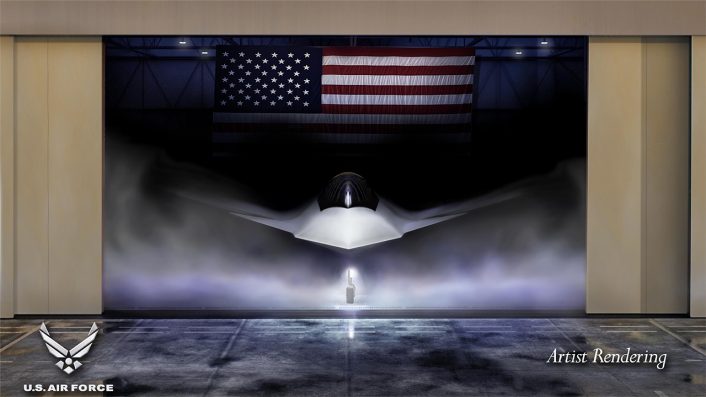Engine manufacturer Pratt & Whitney will use new digital design technology to accelerate its work on the XA103, its submission for the U.S. Air Force’s Next Generation Adaptive Propulsion (NGAP) program.
Next Generation Adaptive Propulsion, or NGAP, calls for the development of adaptive cycle engines that can be reconfigured in flight between high performance and high efficiency modes by adjusting the engine’s bypass ratio. The winning design from the program is expected to eventually power the U.S. Air Force’s next generation fighter, the Boeing F-47, though with NGAP not expected to be finalised until 2030 there is a strong possibility that initial models will have to rely on an interim engine option.
RTX’s Pratt & Whitney is offering the XA103 design for the NGAP project, going head to head with GE Aerospace’s XA102. Both engines have been influenced by previous adaptive cycle designs produced by both companies under the Adaptive Engine Transition Program (AETP), intended to develop a new powerplant for the F-35 Lightning II. AETP was scrapped in 2023 in favour of more incremental upgrades to the existing F135 engine, but lessons learned during the program have not been forgotten.

Both the XA102 and XA103 passed detailed design reviews earlier this year. Ground testing of prototype models is expected to commence towards the late 2020s. Both companies are leveraging new design techniques and technology to accomplish work at a much faster rate.
President of Military Engines for Pratt & Whitney, Jill Albertelli, remarked that “We are paving the way with digital on NGAP, so much so that the rate at which we are delivering XA103 technical data packages has doubled. Model-based design ties all the puzzle pieces together, fostering constant collaboration, and we are applying these learnings across our engine portfolio.”
The company has privately invested $30 million over the course of this year into its model-based environment, which will benefit the design processes for all engines produced by the company. More than 1000 engineers and support personnel are expected to work on the XA103 program, and it will draw upon components and resources from over 100 suppliers.
Pratt & Whitney’s next milestone for the XA103 will be the completion of an Assembly Readiness Review, which is hoped to nail down the timeline for the engine prototype’s build and testing phases over the coming few years. Production of parts for the prototype engine began earlier this year, as announced in July 2025.
ICYMI: Pratt & Whitney cuts metal and releases imagery of its digitally designed NGAP offering for the @usairforce – the XA103 engine.
Read more details on @AviationWeek: https://t.co/glZI2zNvXc pic.twitter.com/8t1f98pdq1
— RTX (@RTX_News) July 11, 2025
Adaptive Cycle Engines
The U.S. Air Force has been seeking adaptive cycle engines for its frontline fighters for decades, but has yet to operationally field any design. Prototypes in the Advanced Tactical Fighter (ATF) competition, the YF-22 and YF-23, carried competing powerplants from GE and Pratt & Whitney. GE’s design, the YF120 was a type of adaptive cycle engine that used a double bypass system that could either operate like a conventional low bypass turbofan, or direct airflow away from the bypass chamber and into the engine’s hot core for additional power at the cost of fuel efficiency. In the end, Pratt & Whitney’s more conventional F119 engine was selected and eventually powered the F-22 Raptor.
Instead of a double bypass design, the XA102 and XA103 engines use a three-stream system. Alongside the usual core stream and bypass stream is an additional stream of air which can be redirected as required for different performance levels. The previous AETP designs, the XA100 and XA101, also utilised this concept.
The high efficiency mode may be crucial to how the U.S. Air Force hopes to achieve a maximum combat radius on the F-47 of almost double that of an F-22. Performance statistics teased by U.S. Air Force Chief of Staff General David Allvin suggests the F-47 is expected to deliver a 1000+ nautical mile combat radius, compared to the F-22’s 590 nautical miles. In this mode, which sees more air diverted via the ‘cold’ bypass chamber, the aircraft will also be able to, to a degree, moderate its emitted heat signature. While the F-47 is expected to surpass even the F-22’s stealthiness to radar, the heat produced by high performance jet engines is still a vulnerable target for infrared search and tracking (IRST) sensors – which are widely used by opposing aircraft – and infrared guided missiles.
For a computer, greater signal to noise ratios are required to effectively track a target. This is why imaging infrared is preferable to optical contrast. Shown below is the last few seconds of flight of an AIM-9X.
This uses imaging infrared to detect and track the target. pic.twitter.com/2izYmSF49R
— Heatloss (@heatloss1986) June 24, 2025
As well as providing for the aircraft’s planned Mach 2+ top speed, the F-47’s engines will need to be able to deliver an adequate amount of electrical supply to power a wide array of advanced electronics. In the future, this could even begin to include directed energy weapons, and a sufficient power overhead needs to be catered for to allow for future developments of aircraft sensors and electronic warfare (EW) capabilities.
Engine design is thought to be one area where the west, and particularly the United States, still maintains a strong edge over Russia and China. China’s J-20 stealth fighter only began to receive its domestically produced WS-15 engines in 2023, in place of WS-10 engines which are largely the same as the ones used on Chinese Su-27 derivatives like the J-11. It’s likely that the widely reported prototype fighters seen operating in China over the past year utilise more traditional engine designs like these, rather than advanced adaptive cycle engines. This is even more reinforced by the apparent need to include three engines on one such design, suggesting an inability to attain high thrust outputs comparable to U.S. and allied engines.









